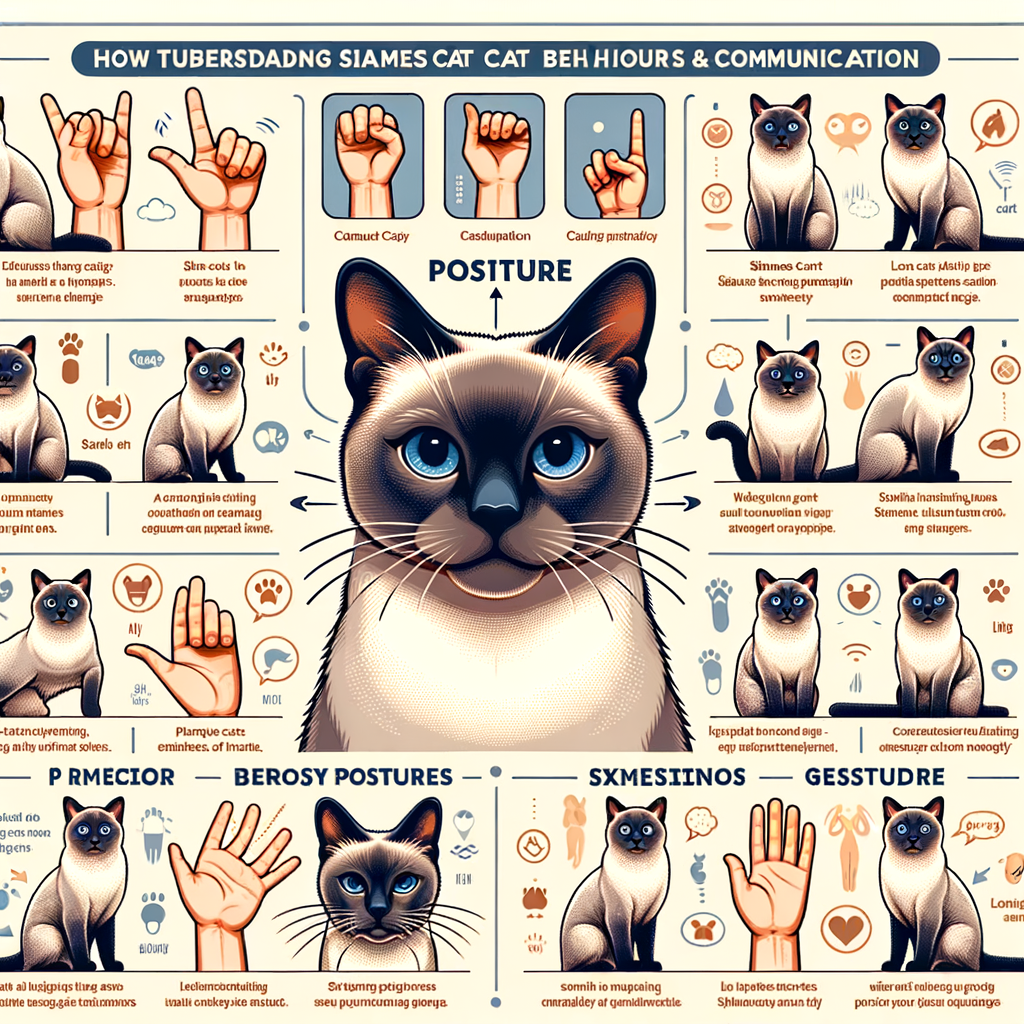
Introduction to Siamese Cat Behavior
Siamese cats are known for their striking features and distinctive personalities. They are one of the oldest and most recognizable cat breeds in the world. However, their behavior sets them apart from other felines. Let’s delve into the fascinating world of Siamese cat behavior.
- Overview of Siamese Cat Behavior
- Unique Traits of Siamese Cats
Siamese cats are highly sociable and love to be the center of attention. They are known for their vocal nature and are often seen engaging in conversations with their owners. Siamese cats are intelligent and curious, always eager to explore their surroundings. They are also known for their strong bond with their human companions, often following them around the house.
One of the unique traits of Siamese cats is their ‘talking’ behavior. They have a wide range of vocalizations and often use them to communicate their needs and feelings to their owners. Siamese cats are also known for their agility. They love to climb and jump, and they are excellent hunters. Their striking blue almond-shaped eyes are not just beautiful but also very expressive. They use their eyes, along with their body language, to communicate.
In the following sections, we will delve deeper into understanding Siamese cat communication, decoding their body language, and interpreting their expressions. By the end of this article, you will be well-versed in the art of reading Siamese cat body language.
Understanding Siamese Cat Communication
Siamese cats are known for their unique communication style. They are one of the most vocal breeds of cats and use a variety of sounds to express their feelings and needs. Let’s delve into the world of Siamese cat verbal communication.
Verbal Communication
Siamese cats have a rich vocabulary of sounds. They use these sounds to communicate with their human companions. Understanding these sounds can help you build a stronger bond with your Siamese cat.
- Common Sounds and Their Meanings
- Interpreting Siamese Cat Vocalizations
Siamese cats make a variety of sounds, each with its own meaning. Here are some common sounds and their interpretations:
| Sound | Meaning |
|---|---|
| Purr | Contentment, happiness |
| Hiss | Fear, anger, or discomfort |
| Chirp | Excitement, attention-seeking |
| Meow | General communication, can mean various things depending on the tone and volume |
Remember, these are general interpretations. Each Siamese cat is unique and may have its own variations of these sounds.
Interpreting Siamese cat vocalizations requires patience and observation. Pay attention to the context in which the sound is made. For example, a meow during mealtime probably means your cat is hungry. A hiss when a stranger enters the room indicates fear or discomfort.
Also, notice the tone and volume of the sound. A loud, harsh meow might indicate distress, while a soft, purring sound usually means contentment. Over time, you’ll learn to understand your Siamese cat’s unique language.
Understanding your Siamese cat’s verbal communication can greatly enhance your relationship with them. It allows you to respond to their needs more effectively and build a stronger bond of trust and affection.
Non-Verbal Communication
Just like humans, Siamese cats communicate a great deal through non-verbal cues. Understanding these cues can help you better understand your furry friend’s needs and emotions.
- Understanding Siamese Cat Body Language
Siamese cats are known for their expressive body language. Here are a few common body language signs and what they mean:
| Body Language | Meaning |
|---|---|
| Arched Back | This usually means your Siamese cat is frightened or angry. |
| Relaxed Tail | A relaxed tail often indicates a content and happy cat. |
| Flattened Ears | If your Siamese cat’s ears are flat, they might be feeling threatened or annoyed. |
Remember, every cat is unique. These are general guidelines, but your Siamese cat may have its own unique ways of expressing itself.
- Reading Siamese Cat Signals
Reading your Siamese cat’s signals can be a bit like learning a new language. It takes time and patience, but the reward is a deeper understanding of your feline friend.
For example, if your Siamese cat is purring and rubbing against you, this is a clear signal of affection. On the other hand, hissing or growling is a sign that your cat is upset or frightened.
By paying close attention to your Siamese cat’s non-verbal cues, you can better understand their needs and emotions, leading to a happier and healthier relationship.
Decoding Siamese Cat Body Language
Understanding the body language of your Siamese cat can be a fascinating and rewarding experience. It allows you to communicate more effectively with your feline friend and understand their needs and feelings. Let’s delve into some of the most common body language signs you may notice in your Siamese cat.
Siamese Cat Body Language Signs
Siamese cats, like all felines, use their bodies to express a variety of emotions and intentions. Here are some key signs to look out for:
- Tail Movements
- Ear Positions
- Eye Expressions
- Body Postures
The tail of a Siamese cat is a powerful communication tool. A high, straight-up tail often indicates happiness and confidence, while a low or tucked tail can suggest fear or submission. A tail that swishes rapidly from side to side may signal irritation or excitement.
The ears of a Siamese cat can also reveal a lot about their mood. Ears that are pricked up and facing forward indicate interest and alertness. If the ears are flattened against the head, it could mean that the cat is scared or angry.
Siamese cats have striking blue eyes that they use to communicate. Wide-open eyes can show surprise or fear, while half-closed eyes can indicate contentment. If your Siamese cat is blinking slowly at you, it’s a sign of trust and affection.
The way a Siamese cat positions its body can also tell you a lot about its state of mind. A relaxed cat will have a loose, open body posture, while a scared or aggressive cat may arch its back and puff up its fur to appear larger.
By paying close attention to these body language signs, you can gain a deeper understanding of your Siamese cat’s emotions and needs. Remember, every cat is unique, and it may take time and patience to fully understand your feline friend’s body language.
Interpreting Siamese Cat Gestures
Siamese cats are known for their expressive gestures. These gestures can tell us a lot about what they’re feeling or thinking. Let’s delve into some common Siamese cat gestures and their meanings. We’ll also look at a case study to understand these gestures in different scenarios.
- Common Gestures and Their Meanings
- Case Study: Siamese Cat Gestures in Different Scenarios
Siamese cats have a unique set of gestures that they use to communicate. Here are some common ones:
| Gesture | Meaning |
|---|---|
| Arching Back | This usually means the cat is scared or threatened. |
| Purring | Often a sign of contentment, but can also indicate discomfort or stress. |
| Slow Blinking | This is a sign of trust and affection. |
Remember, each cat is unique and may have its own variations of these gestures.
Let’s look at a case study of a Siamese cat named Bella. Bella’s owner noticed that she often arched her back when a new person entered the room. After some observation, they realized that Bella was feeling threatened by the unfamiliar presence. However, when Bella was around her owner, she often purred and blinked slowly, indicating trust and affection.
This case study shows how understanding Siamese cat gestures can help us better cater to their needs and ensure their comfort.
Interpreting Siamese cat gestures can be a fascinating and rewarding experience. It allows us to understand our feline friends better and build a stronger bond with them. So, keep observing and learning!
Siamese Cat Expressions: What They Mean
Siamese cats are known for their expressive eyes and body language. They have a unique way of communicating their emotions, which can be fascinating to observe. Understanding these expressions can help you better connect with your Siamese cat. Let’s explore what different expressions mean.
- Happy Siamese Cat Expressions
- Angry Siamese Cat Expressions
- Scared Siamese Cat Expressions
When a Siamese cat is happy, they will have relaxed body language. Their tail will be upright, with a slight curve at the end, and their ears will be forward-facing. The eyes will be half-closed, giving them a content look. They may also purr or knead with their paws, which is a sign of contentment.
On the other hand, an angry Siamese cat will have a stiff body and flattened ears. Their tail may be puffed up and their eyes will be wide open. They may also hiss or growl. If you notice these signs, it’s best to give your cat some space to calm down.
When a Siamese cat is scared, they will try to make themselves look bigger. They will arch their back, puff up their fur, and their tail will stand straight up. Their eyes will be wide open and their ears will be flattened. They may also hiss or spit as a warning. It’s important to reassure a scared cat and remove any potential threats.
Understanding your Siamese cat’s expressions can greatly enhance your bond with them. It allows you to respond appropriately to their needs and emotions, making them feel safe and loved. Remember, each cat is unique, so these are general guidelines and your cat may have their own unique ways of expressing themselves.
Siamese Cat Body Language Guide: Key Takeaways
As we conclude our exploration of Siamese cat body language, let’s recap the most important points. Understanding your Siamese cat’s body language is not just about satisfying your curiosity; it’s about improving the bond between you and your feline friend. Here are the key takeaways:
- Importance of Understanding Your Siamese Cat’s Body Language
- How to Respond to Different Body Language Signs
- Improving Your Relationship with Your Siamese Cat Through Better Communication
Understanding your Siamese cat’s body language is crucial for a harmonious coexistence. Cats, including Siamese, communicate primarily through body language. According to a study, 90% of their communication is non-verbal. By understanding their body language, you can better meet their needs, prevent potential conflicts, and strengthen your bond.
Responding correctly to your Siamese cat’s body language signals can greatly enhance your relationship. For instance, a raised tail usually indicates happiness and a willingness to interact, while flattened ears may signal fear or aggression. By responding appropriately, you can reassure your cat, build trust, and avoid unnecessary stress or conflict.
Improving communication with your Siamese cat is not a one-day task; it requires patience and consistency. The more you observe and interact with your cat, the better you’ll understand their unique signals and behaviors. This understanding can lead to a deeper, more rewarding relationship with your Siamese cat.
In conclusion, understanding and responding to your Siamese cat’s body language can greatly improve your relationship. It allows you to meet their needs, avoid conflicts, and build a strong, loving bond. Remember, every cat is unique, so take the time to learn and understand your Siamese cat’s individual behaviors and signals.
Conclusion: The Art of Reading Siamese Cat Body Language
Understanding the body language of your Siamese cat is more than just a skill; it’s an art. It requires patience, attention to detail, and a deep bond with your feline friend. Let’s recap what we’ve learned and share some final thoughts on this fascinating topic.
- Recap of Siamese Cat Body Language Signs
- Final Thoughts on Siamese Cat Communication
Throughout this guide, we’ve explored various signs of Siamese cat body language. We’ve learned that a raised tail often signifies happiness, while flattened ears may indicate fear or aggression. We’ve discovered that a slow blink from a Siamese cat is a sign of trust and affection, and that a puffed-up tail can mean they’re scared or excited.
Remember, every cat is unique. While these signs provide a general guideline, your Siamese cat may have its own unique ways of expressing its feelings. The key is to spend time with your cat, observe its behavior, and learn to understand its unique language.
Siamese cats are known for their vocalizations, but their body language is just as expressive. By learning to read these subtle signs, you can deepen your bond with your Siamese cat and better understand its needs and emotions.
Remember, understanding your cat’s body language is a journey, not a destination. It’s a continuous process of learning and discovery that can bring you closer to your feline friend. As the famous quote goes, “The smallest feline is a masterpiece.” – Leonardo da Vinci. And understanding their language is a step towards appreciating this masterpiece.
In conclusion, the art of reading Siamese cat body language is a rewarding endeavor that can enhance your relationship with your pet. It’s a language of love, trust, and mutual respect. So, keep observing, keep learning, and keep enjoying the wonderful world of Siamese cats.








